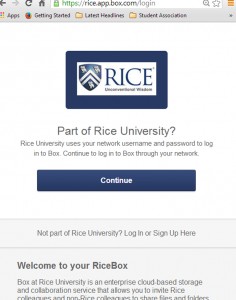Traditional electronic storage solutions for Rice faculty, staff, and students proved insufficient for massive data sets amassed by researchers starting around 2010, and several Rice researchers turned to external solutions. After free solutions were exhausted, researchers began returning to Rice for storage solutions. As BCB Faculty Fellow Dr. Daniel Harrington explained, “Everybody’s Dropbox is getting full and we don’t want to have to pay for more storage.” The results of an IT Task Force survey also indicated that university-funded storage for research data was a high priority for Rice faculty.

In 2013, IT began exploring storage options and ran a trial program in the fall. Rice contracted with Box.com, an external collaboration and storage service provider, to offer 30 gigabytes (GB) of electronic storage to all Rice faculty and staff. Rice Box rolled out shortly after spring break 2014 as the first of several new storage solutions for faculty and staff. Rice undergraduates and graduate students will be able to share files with their faculty sponsors in the fall.
Rice Box is a U.S.-based cloud solution. This means that although the data saved in Rice Box is not stored in the university’s footprint, it is stored somewhere in the United States. This is important from a security aspect. External service providers often offer free storage solutions, but the data may be housed anywhere around the world, and their server clusters transfer files from base to base as storage needs fluctuate. For sensitive and confidential information like grant proposals and collected research data, the uncertainty of where the data lives is unacceptable.
The most important feature that Rice Box offers participants is collaboration. Documents can be shared with Rice community members as well as external partners. When a document is updated, all participants can receive a notification by email. Comments are also shared and saved inside Rice Box, so it is easy to login and see the most recent activity. “The standard way of collaborating on a grant proposal was by emailing updates to all the participants. So you’d get version 7, no wait, was that 7a or 7b?” said Harrington. “It was very confusing. So with Box, you login and here’s the most current version. We store all the former versions in a ‘Previous Versions’ folder. A lot of our research collaborators are with other universities, so this is much better than having one administrator and wondering what version [of a document they are using]. The transparency and access are great.” For Rice researchers like Harrington, who has used cloud-based collaboration for more than 20 grant proposals and research papers, tracking only the most current version of data and documents is critical.

“And we’re also using OWL-Space for research projects,” he said. “Once we found out that you can use OWL-Space for collaborative projects, and that it comes with a gigabyte of space per project, we began requesting logins for our external collaborators. It became a great additional solution that replicated much of Dropbox’s functionality.”
For everyday work on projects, “Box has been a great way for me to store and access my instrument procedures,” added Harrington. “At Rice, users of the SEA (Shared Equipment Authority) are required to bring their own documentation when they use the instruments. But in the Clean Room in Abercrombie, there is a ‘no paper’ rule due to particulate release from the paper fibers. So I pull out my iPhone or iPad and look up the manual I’ve saved in my Box account.”

